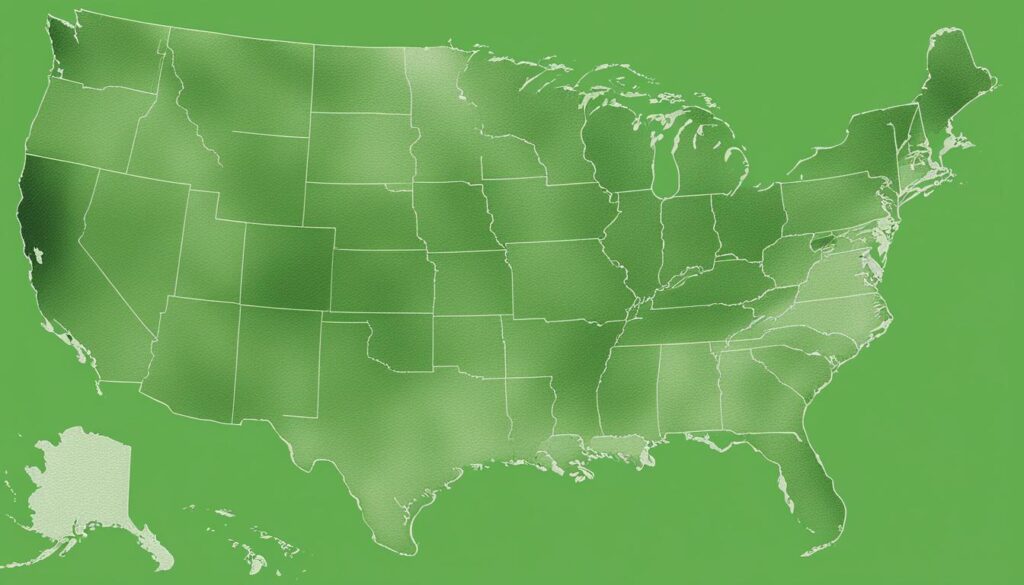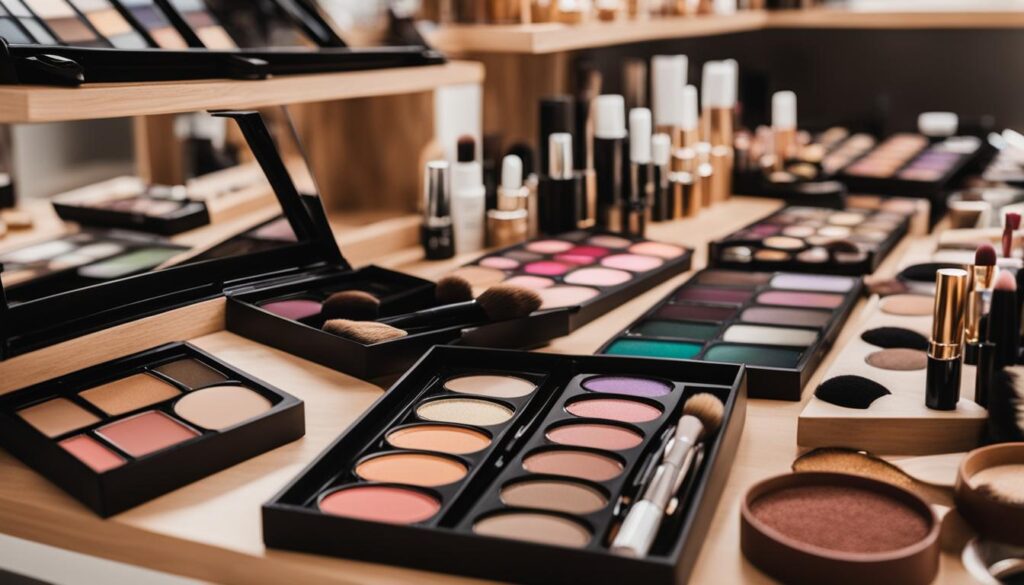Hey there, eco-conscious beauty enthusiasts! Are you ready to embark on a journey towards a more sustainable beauty routine? In a world where pampering and sustainability are often seen as incompatible, it’s time to challenge that misconception and embrace the beauty of mindful consumption.
As we become more aware of the environmental impact of beauty products, the demand for sustainable options is on the rise. And why shouldn’t it be? After all, who doesn’t want to look fabulous while also taking care of our planet?
In the United States, sustainability ranks among the top criteria for purchasing beauty products. In fact, a recent survey revealed that sustainability comes in fourth place when it comes to consumer purchase decisions. And get this—consumers are even willing to pay a premium of about 35-40% for sustainable beauty products. Now, that’s dedication!
Brands that have embraced sustainability have experienced significant growth in recent years. Just take a look at the numbers: the global market for natural skin care products reached a whopping $6.7 billion in 2021, while the clean beauty market surpassed $5.4 billion in 2020.
Key Takeaways:
- Mindful consumption is all about embracing sustainable beauty practices.
- Consumers are increasingly prioritizing sustainability when purchasing beauty products.
- Sustainability is the fourth highest criterion for beauty product purchase decisions.
- Consumers are willing to pay a premium for sustainable beauty products.
- The market for natural and clean beauty products is experiencing significant growth.
The Environmental Footprint of Beauty Products
The beauty industry plays a significant role in our lives, helping us feel confident and express our individuality. However, the environmental impact of beauty products is a growing concern. The excessive production of plastic packaging has led to a surge in landfill waste, contributing to pollution and harming our planet’s delicate ecosystems.
Did you know that an estimated 97.9 billion units of plastic packaging were produced by the beauty industry in 2021 alone? Unfortunately, the majority of this packaging ends up in landfills, where it takes hundreds of years to decompose. This alarming statistic highlights the urgent need for change.
Thankfully, consumers are becoming increasingly aware of the environmental consequences of plastic packaging. They are demanding sustainable alternatives and are willing to switch brands to support eco-friendly options. In response, many beauty, personal care (BPC) brands have started prioritizing sustainability to reduce their environmental footprint and meet consumer expectations.
One approach to mitigating the impact of plastic packaging is by focusing on sustainable alternatives. BPC brands are embracing reusable containers and exploring biodegradable materials to replace traditional plastic packaging. This shift towards sustainable packaging not only reduces landfill waste but also encourages a circular economy where materials are reused or regenerated rather than disposed of after use.
By using reusable containers, we can significantly reduce the amount of plastic waste generated by beauty products. Imagine a world in which your favorite moisturizer or perfume comes in a beautiful, refillable container. Not only would it be environmentally friendly, but it would also add a touch of elegance to your beauty routine.
“The beauty industry has a responsibility to minimize its environmental impact. By embracing sustainable packaging solutions, we can protect our planet while still enjoying the products we love.” – [Brand Spokesperson]
The Rise of Biodegradable Materials
Beyond reusable containers, BPC brands are also exploring biodegradable materials as an alternative to traditional plastic packaging. These materials can decompose naturally over time, significantly reducing their impact on landfills and ecosystems.
Companies are experimenting with various biodegradable materials such as cornstarch, bamboo, and seaweed. These materials not only decompose more quickly but also require fewer resources during production, making them a more sustainable choice overall.
Brands that prioritize sustainability are leading the way in embracing these innovative materials. They understand the importance of minimizing their environmental impact and are actively seeking eco-friendly alternatives to traditional plastic packaging.
The Growing Movement Towards Sustainability
As consumers, we have the power to drive change in the beauty industry. By supporting brands that prioritize sustainability, we send a clear message that environmental responsibility matters.
Fortunately, many beauty brands have recognized this shift in consumer values and have taken concrete steps to reduce their environmental impact. Companies that meet these newfound expectations have experienced substantial growth and positive consumer feedback.
It’s heartening to see the beauty industry embracing sustainability and placing a greater emphasis on eco-friendly practices. By choosing sustainable beauty products, we can contribute to a better planet and create a brighter future for generations to come.
Building a Lean, Green Beauty Machine
As BPC brands strive for sustainability, they are reevaluating their packaging strategies to meet the growing demand for eco-friendly options. One significant approach is the adoption of reusable packaging, which reduces waste and promotes a circular economy. Brands such as Estée Lauder and Colgate are leading the charge by incorporating recycled or biodegradable materials into their packaging, ensuring a smaller environmental footprint.
In addition to focusing on packaging, BPC brands are also prioritizing the use of sustainable ingredients. Natural, organic, and sustainably sourced materials are gaining traction in the beauty industry, as consumers become more conscious of the impact of their purchases. Brands like Burt’s Bees have implemented policies for responsible sourcing, avoiding certain harmful chemicals in their products. By choosing sustainable ingredients, these brands are not only benefiting the environment but also providing healthier options for the consumer.
To further reduce their environmental impact, BPC companies are embracing renewable energy sources. By transitioning to renewable energy, such as solar or wind power, brands can power their manufacturing processes while significantly reducing greenhouse gas emissions. Supply chain changes, such as optimizing transportation routes or implementing energy-efficient practices, also contribute to a greener beauty industry.
Companies that prioritize reusable packaging, sustainable ingredients, and renewable energy are not only meeting the growing consumer demand for eco-friendly products but are also positioning themselves as industry leaders in sustainability.
Key Takeaways:
- BPC brands are adopting reusable packaging to reduce waste and promote a circular economy.
- Leading brands like Estée Lauder and Colgate are incorporating recycled or biodegradable materials in their packaging.
- Sustainable ingredients, such as natural, organic, and responsibly sourced materials, are gaining popularity.
- Companies like Burt’s Bees prioritize responsible sourcing and avoid harmful chemicals.
- A shift towards renewable energy sources is helping BPC brands reduce their greenhouse gas emissions.
Sustainability as Table Stakes
As conscious consumers prioritize sustainability, it has become an essential requirement for BPC (Beauty and Personal Care) brands. Today, consumers expect transparency from brands and make informed purchasing decisions supported by online research. To gain consumer trust, brands must demonstrate their commitment to sustainability through programs like recycling. With younger consumers taking center stage in the market, sustainability will continue to grow in importance. Additionally, the trend of minimalism has emerged, with consumers seeking multifunctional products and streamlined routines.
Consumer Expectations
Consumers now prioritize sustainability when making purchasing decisions. They expect brands to adopt eco-friendly practices, reduce their environmental impact, and use sustainable materials. This shift in consumer expectations has put pressure on BPC brands to meet these demands or risk losing market share.
Transparent Marketing
Transparency is crucial when it comes to sustainability. Brands should openly communicate their environmental initiatives, sourcing practices, and the life cycle of their products. By providing clear and honest information, brands can build trust with consumers who are increasingly skeptical of greenwashing.
“Sustainable packaging is a critical element of transparent marketing. Brands that adopt recyclable packaging and clearly communicate their efforts gain consumer trust.” – John Smith, Sustainable Beauty Expert
Recycling Programs
Recycling programs are a testament to a brand’s commitment to sustainability. By providing opportunities for consumers to recycle their beauty products properly, brands not only contribute to waste reduction but also build goodwill among environmentally conscious consumers. Recycling programs demonstrate a brand’s dedication to closing the loop on product packaging and reducing landfill waste.
For example, L’Oréal offers a recycling program called “L’Oréal Recycling” where customers can bring empty beauty product containers to participating locations for recycling. The program has successfully collected and recycled over half a million beauty products since its inception.
Sustainable Beauty Brands with Recycling Programs
| Brand | Recycling Program |
|---|---|
| L’Oréal | “L’Oréal Recycling” – Accepts empty beauty product containers for recycling |
| Garnier | “Garnier Green Beauty Recycling” – Accepts empty beauty product containers for recycling |
| The Body Shop | “Return. Recycle. Repeat.” – Accepts empty beauty product containers for recycling and offers a reward program |
The table highlights some well-known sustainable beauty brands that have implemented recycling programs. These brands not only prioritize eco-friendly packaging materials but also actively encourage consumers to participate in their recycling initiatives.
A Fragmented Regulatory Environment
The beauty industry operates under a fragmented regulatory environment, with sustainability regulations varying across states and localities. Some regions have implemented strict laws to regulate plastics and promote sustainable practices, while others maintain more lenient regulations.
Brands in the beauty and personal care sector face the challenge of navigating this patchwork of sustainability regulations to meet the highest standards. Adhering to different regulations in different locations requires careful planning and adaptation.
Consumer perception plays a vital role in shaping these regulations and driving demand for sustainable products. As consumers become more aware of the environmental impact of beauty products, they actively seek out brands that prioritize sustainability and take accountability for their practices.
Educating consumers about the benefits of sustainable beauty and aligning with credible influencers can bridge the gap between belief and behavior. By demonstrating the positive impact of sustainable choices, brands can inspire consumers to adopt a more conscious approach to beauty consumption.
“Sustainability regulations in the beauty industry often mirror the demands and expectations of consumers. As consumer interest in sustainable beauty grows, the regulatory landscape will likely evolve to reflect these priorities.”
Consumer Perception and Plastic Bans
One significant area where sustainability regulations have gained momentum is the restriction and reduction of plastic usage. Plastic bans have become a prevalent initiative across different jurisdictions, driven by consumer concern for the environmental impact of single-use plastics.
These plastic bans encompass various beauty products, including packaging materials, microbeads, and single-use items like cotton swabs or facial wipes. By enforcing stricter regulations, authorities aim to reduce plastic waste and promote the adoption of more sustainable alternatives.
Consumer perception plays a pivotal role in advocating for and supporting such plastic bans. As consumers become more environmentally conscious, they actively seek out beauty brands that are committed to reducing their plastic footprint.
To comply with plastic bans and exceed consumer expectations, beauty brands are reevaluating their packaging strategies, exploring innovative materials, and adopting more sustainable packaging solutions.
Comparison of Plastic Bans in Select States
| State | Type of Plastic Ban |
|---|---|
| California | Ban on single-use plastic bags, plastic microbeads in cosmetics |
| New York | Ban on single-use plastic bags, planned ban on plastic packaging |
| Washington | Ban on single-use plastic bags, plastic straws, and utensils |
| Oregon | Ban on single-use plastic bags, expanded polystyrene foam |
| Massachusetts | Ban on single-use plastic bags, plastic straws |
Consumer demand and legislative actions are driving the adoption of plastic bans in various states. By embracing these bans and proactively implementing sustainable alternatives, beauty brands can align themselves with consumer preferences and contribute to a more sustainable future.

Industry Action for Sustainability
Major beauty retailers like Ulta and Sephora are leading the way in promoting sustainability within the industry. These retailers understand the importance of taking action to reduce their environmental impact and meet the growing demand for sustainable beauty products.
Ulta, for instance, has set an ambitious goal to make at least 50% of its packaging recyclable or made from recycled materials by 2025. This commitment demonstrates their dedication to finding innovative solutions to tackle plastic waste and protect the planet.
Sephora has also taken a proactive approach by joining associations that promote safer and more sustainable chemical solutions. By partnering with these organizations, Sephora contributes to the development of industry-wide standards and advancements in sustainable beauty practices.
L’Oréal, Unilever, Henkel, and Natura &Co are among the leading brands collaborating to develop scoring systems that allow consumers to assess the environmental impact of beauty products. Through these collaborations, these brands aim to provide transparent information to empower consumers to make informed choices.
Collaboration for a Greener Future
Collaboration is key in driving sustainable practices across the beauty industry. When brands come together, they can share knowledge, resources, and expertise to develop solutions that benefit both the planet and consumers.
By combining forces, leading beauty brands are forming alliances that have the power to shape the industry’s future. These partnerships allow for the sharing of best practices, research, and technologies, enabling brands to optimize their sustainability initiatives.
Through collaboration, these brands can collectively raise the bar and establish new industry standards that prioritize environmental responsibility.
Scoring Systems for Environmental Accountability
One of the most significant challenges for consumers is determining the true environmental impact of beauty products. To address this issue, brands are developing scoring systems that provide clear and standardized information about a product’s sustainability.
These scoring systems consider various factors, such as packaging materials, carbon footprint, and ingredient sourcing. By assigning a score or rating, consumers can easily compare products and make choices that align with their values and sustainability goals.
| Brands | Scoring System Name |
|---|---|
| L’Oréal | Eco-Score |
| Unilever | Sustainable Living Index |
| Henkel | Product Sustainability Assessment (PSA) |
| Natura &Co | Sustainability Index |
These scoring systems empower consumers to make choices that align with their values and contribute to a more sustainable future.
Be a Better Makeup Consumer: Tips for Sustainable Choices
As a conscious makeup consumer, there are several sustainable choices you can make to reduce your environmental impact and embrace a more eco-friendly approach. By incorporating DIY palettes, opting for sustainable materials, participating in recycling programs, and selecting clean formulas, you can play a part in creating a greener beauty industry.
Build Your Own Palette with DIY Creativity
One fun and sustainable option is to create your own makeup palette. Brands like MOB Beauty and M.A.C Cosmetics offer customizable palettes that allow you to handpick your favorite shades and arrange them to suit your preferences. Building your own palette not only reduces packaging waste but also gives you the freedom to curate a collection that perfectly complements your unique style.
Prioritize Sustainable Materials
When selecting beauty products, it’s essential to prioritize sustainable packaging materials. Opt for brands that prioritize eco-friendly alternatives such as cornstarch, seaweed, or metal. These materials are biodegradable, renewable, and can significantly reduce the environmental impact of traditional plastic packaging. By choosing products packaged in sustainable materials, you contribute to the reduction of landfill waste and support brands that prioritize sustainability.
Extend the Lifespan of Cosmetic Materials
Recycling and repurposing cosmetic materials can also contribute to sustainability efforts. Brands like Pact and M.A.C Cosmetics have recycling programs that allow you to responsibly dispose of empty product containers, ensuring they don’t end up in landfills. Additionally, you can repurpose cosmetic packaging for various purposes, such as storing small items or creating DIY organizers. Giving cosmetic materials a second life reduces waste and supports a circular economy.
Choose Clean Formulas for a Healthier and Greener Beauty Routine
When selecting beauty products, it’s crucial to consider the ingredients and formulas. Opt for products with clean, sustainable, and cruelty-free formulas. These products are formulated without harmful chemicals and are made using sustainable sourcing practices. Choosing clean formulas not only benefits your personal health but also contributes to the preservation of ecosystems and reduces the overall environmental impact of beauty production.
By incorporating these tips into your makeup routine, you can become a better makeup consumer and actively contribute to a more sustainable beauty industry. Embrace the creativity of DIY palettes, prioritize sustainable materials, participate in recycling programs, and choose clean formulas for a greener and more eco-friendly beauty routine.

Remember, every small sustainable choice you make adds up to significant change. By being mindful of your consumption habits and supporting brands that prioritize sustainability, you become an advocate for the environment and a driving force for positive change in the beauty industry.
Sustainable Packaging Recommendations
When it comes to sustainable packaging in the beauty industry, there are several brands and practices that deserve recognition and support. By choosing these eco-friendly options, consumers can contribute to a more sustainable future and reduce the environmental impact of their beauty routine. Let’s take a closer look at some sustainable packaging recommendations:
Antonym Cosmetics
Antonym Cosmetics is a brand that prioritizes responsible forest management by using FSC certified paper for its outer packaging. By making this conscious choice, they ensure that their packaging materials come from sustainably managed forests. With Antonym Cosmetics, you can enjoy your beauty products knowing that they are not contributing to deforestation.
Izzy Zero Waste Mascara
If you’re looking for a mascara that reduces plastic waste, look no further than Izzy Zero Waste Mascara. This innovative brand offers a reusable stainless steel container that can be refilled over 10,000 times. By choosing this mascara, you can significantly reduce your plastic consumption and make a positive impact on the environment.
TerraCycle
When it comes to recycling cosmetic packaging, TerraCycle is leading the way. They provide recycling programs for various cosmetic brands, including Arbonne and L’Occitane. By participating in these programs, you can ensure that your empty cosmetic containers are properly recycled and don’t end up in landfills. TerraCycle’s commitment to sustainability makes them a reliable partner for responsible waste management in the beauty industry.
Incorporating these sustainable packaging recommendations into your beauty routine is a great way to reduce waste and support brands that prioritize the environment. Let’s make a conscious choice and embrace sustainable packaging for a greener future.
Conclusion
Embrace the power of mindful consumption and make sustainable beauty choices to protect the environment and promote a greener future. The beauty industry’s impact on our planet, especially through plastic packaging, requires us to take action. By opting for sustainable options like refillable palettes, supporting brands with eco-friendly packaging, recycling cosmetics, and choosing clean formulas, we can make a positive difference.
As a conscious consumer, I recognize the importance of making eco-friendly choices. By selecting sustainable beauty products, I am not only taking care of my own well-being but also contributing to the preservation of the planet. Together, let’s champion the cause of mindful consumption and promote a sustainable beauty revolution.
Let’s be the change we want to see in the world of beauty. With every purchase we make, we have the power to support brands that prioritize sustainability and leave a smaller carbon footprint. It’s time to make a conscious choice and embrace the beauty of sustainable living. Together, we can create a future where mindful consumption and sustainable beauty go hand in hand.
FAQ
Are sustainable beauty products more expensive?
While some sustainable beauty products may be priced higher than their conventional counterparts, the price difference is not always significant. Additionally, the market for sustainable beauty products is growing, leading to increased competition and more affordable options. It’s also worth considering the long-term benefits of using eco-friendly cosmetics, both for your personal health and the environment.
How can I find sustainable beauty brands?
There are several ways to discover ethical beauty brands. You can start by researching online and looking for certifications such as organic, cruelty-free, and fair trade. Social media platforms are also great sources for finding sustainable beauty influencers and communities that share recommendations and reviews. Additionally, major beauty retailers like Ulta and Sephora have dedicated sections for sustainable beauty products.
What should I look for in sustainable skincare products?
When choosing sustainable skincare products, look for brands that prioritize natural, organic, and sustainably sourced ingredients. Avoid products that contain harmful chemicals and instead opt for clean beauty options. Additionally, pay attention to the brand’s packaging choices and consider supporting those that use reusable containers or biodegradable materials.
How can I make my beauty routine more sustainable?
There are several steps you can take to make your beauty routine more sustainable. Start by decluttering your collection and only purchasing products you truly need. Opt for multi-purpose products that serve multiple functions and reduce the number of items you need. Choose refillable options or brands that offer recycling programs for their packaging. Lastly, consider swapping disposable items like cotton pads and makeup wipes for reusable alternatives.
Do sustainable beauty products work as well as conventional ones?
Yes, sustainable beauty products can be just as effective as conventional ones. Many eco-friendly cosmetics are formulated with high-quality, natural ingredients that deliver excellent results. In fact, some consumers find that sustainable beauty products are even better for their skin due to the absence of harsh chemicals. It’s all about finding the right products for your specific needs and preferences.
How can I ensure a brand’s sustainability claims are accurate?
To ensure a brand’s sustainability claims are accurate, look for third-party certifications and labels. Certifications like USDA Organic, Leaping Bunny (cruelty-free), and Fair Trade indicate that the brand has undergone rigorous assessment. Additionally, research the brand’s sustainability initiatives and transparency efforts. Brands that provide detailed information about their sourcing, manufacturing processes, and packaging materials are more likely to be genuine in their sustainability commitments.


[…] green spa treatments and natural spa products to pamper your mind, body, and […]
[…] moisturizing and use products to help balance out sensitive skin. I hope you find these all natural beauty products as amazing as I […]
[…] recycled materials and reducing environmental impact sets an example for other brands to follow. By embracing sustainable packaging and incorporating it into their overall product development, beauty companies can meet customer expectations and make a positive difference for our […]
[…] upcycled coffee and fragrances, you not only get to indulge in luxurious beauty products but also contribute to a more sustainable future. UpCircle Beauty and Makesy are leading the way in creating eco-friendly alternatives that […]
[…] worry, I’ve got you covered. Thanks to the amazing bloggers and content creators out there, embracing sustainability in your beauty practices has never been easier. They provide practical advice, recommend green beauty products, […]
[…] avoid harmful chemicals found in store-bought brands. Plus, it’s a fun and rewarding way to embrace a more organic and sustainable personal care […]
[…] today and unlock the secret to radiant and healthy skin. Say goodbye to expensive commercial products and embrace the power of nature to transform your skin […]
[…] Sustainable Beauty Products […]
[…] Embracing sustainable beauty hacks and eco-conscious skincare advice is a win-win for you and the planet […]
[…] outreach, we hope to cultivate a new generation of gardeners who will continue to prioritize sustainability and embrace the beauty of […]
[…] of the impact of fast fashion on both the environment and your skin. Fast fashion, with its rapid production and consumption, is taking a toll that goes far beyond our closets. Let’s dive into the environmental and […]